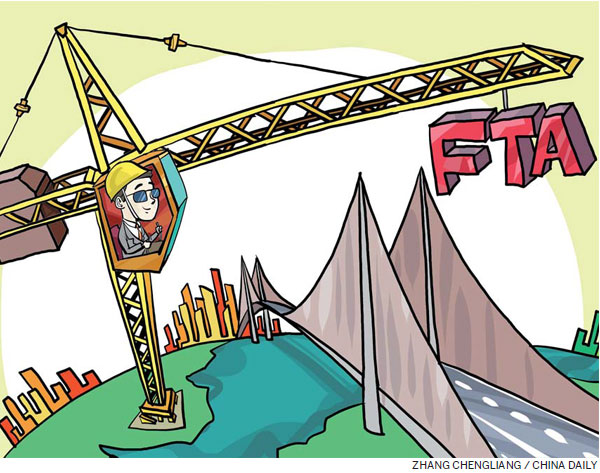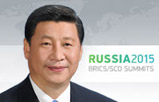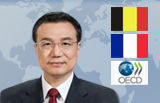China playing central role in free trade
Updated: 2015-07-10 07:25
By Zhang Lin(China Daily Europe)
|
|||||||||||
Beijing is pursuing a multilevel strategy using FTAs to help set new rules for the evolving global economy
China is a latecomer in terms of reaching free trade agreements with other economies. But it has sped up in recent years with the signing of a few landmark FTAs with countries and regions including Switzerland, South Korea and Australia.
On the multilateral front, China is also participating in negotiations for the Regional Comprehensive Economic Partnership and the Free Trade Area of the Asia-Pacific, which have become important for Asia-Pacific regional integration.

Through these efforts, China clearly shows the acceleration of the implementation of its free trade area strategy, which indicates China's confidence and determination to continue to open up wider to the outside world and to actively participate in economic globalization and regional integration.
Indeed, China's FTA strategy has entered a new phase. Its understanding and expectations of FTAs have changed with its increased participation in the global economy. To understand this change, a brief look back at how China developed FTAs might be helpful.
China has experienced three stages in its formulation of FTAs. The first was from 2001 to 2005, when China was testing the waters. One of the major developments during the period was that China and the Association of Southeast Asian Nations reached a consensus on building an FTA in 2001. They signed a package framework agreement on establishing a free trade area in November 2002, marking China's first step on the FTA cooperation framework.
The second stage, from 2005 to 2010, witnessed rapid development in the signing of FTAs. One important milestone during the period was that top policymakers started to view FTAs as a major component of China's opening-up strategy. It was in 2007 that the top leadership in China put forward the idea of implementing the strategy of FTAs and "strengthening bilateral and multilateral economic and trade cooperation". Hence, FTAs became the basis to further promote that goal. But it is noteworthy that the FTAs China signed during the first two periods were mostly with small, developing economies.

Things started to change in 2010, when China's FTA practice entered the third stage. At this stage, "comprehensiveness, high quality and balance of interests" became goals for China's FTA strategy. To achieve these goals, China set higher FTA standards, aiming to integrate itself with international investment practice and rules, expand the scope and depth of FTAs, participate in forming of FTA platforms in East Asia and Southeast Asia, and seek to reach bilateral investment treaties with the United States and the European Union.
Externally, there are a few positive factors for China in advancing its FTA strategy.
First, the Doha round of World Trade Organization negotiations have stagnated on trade liberalization when there was failure to reach a consensus. Thus, many countries are more dependent on trade promoted by the development of regional integration and investment liberalization. It stimulates the construction and development of regional integration and free trade areas. Regional trade increases significantly and signs of trade development show a regionalization trend.
Second, developed economies led by the US are formulating new global investment rules and promoting the standards of FTAs by advancing free trade deals such as the Trans-Pacific Partnership agreement and Transatlantic Trade and Investment Partnership agreement. The evolution of new rules requires China to accelerate FTA cooperation and practice with foreign countries to catch up with global trends.
Internally, China also feels the strong need to expand and update its FTA efforts. In the past, China focused on trade and market diversification when it signed FTAs with other economies. But recently, it has seen new driving forces to promote its FTA efforts.
First, it is the inevitable requirement for deepening and tightening the global value chain. The global value chain of production and trade model promotes regional economic and trade exchanges, and strengthens the degree of geopolitical relationships. The new international division of labor depends on highly efficient production and rationalization of market layout. China's recent FTAs with South Korea and Australia are a result of the formation of the intra Asia-Pacific regional value chain and the pattern of a deepening division of production. Economic and trade relations are increasingly close. This interwoven and interdependent situation is the result of the expansion of trade and investment among regional countries. It is also an important foundation of Asia-Pacific regional economic growth.
Second, an accelerated FTA effort can help promote all-around economic reforms within China. After three decades of reform and opening-up and 10 years of being a member of the World Trade Organization, China has accomplished great achievements, but its reforms have entered a difficult period. From the point of the domestic environment, an increase in wages has led to a surge in export costs, squeezing profit margins. Enterprises are under heavy pressure to survive. Export products are at a relatively low added value in the low end of the division of the industrial chain.
These problems are striking. China's traditional foreign trade development pattern, relying on energy resources and labor, must be changed. China will need to speed up integration with new global trade and investment rules, improve internationalization levels, promote foreign cooperation, and boost domestic reform by opening up. To achieve these goals, China needs to use FTAs to push domestic reforms.
Third, China must enhance its say in regional and global matters by actively participating in FTAs. The world's economic landscape has been transformed. The rise of new emerging economies has caused changes in the dominant force in global trade. The global trade governance pattern is in a period of adjustment. The trend is for economies to influence global economic governance through setting, shaping and implementing global investment and trade rules. One effective way to influence global economic rules is to participate and lead in FTAs.
Against this backdrop, China particularly needs to cement its position in Asia-Pacific FTAs. There are three approaches it could adopt to accomplish this.
China needs to have an open attitude toward the Trans-Pacific Partnership. The TPP, dominated by the US, is leading the future of the global economy and trade rules by establishing high standards for regional agreements. China has realized that it must pay attention to the next generation of trade issues if the country is going to participate in the negotiations of international trade rules and be an important participant in a new round of global trade pattern reconstruction. In the short term, China is not prepared to join the TPP negotiations, but in the long run, high levels and high standards of trade and investment rules are good for China's industrial structure adjustment and upgrading. Therefore, the possibility cannot be ruled out that China will join the TPP talks in the coming years.
In terms of the Regional Comprehensive Economic Partnership, China should let ASEAN lead the pact. At the same time, China needs to uphold the principle of considering the different stages of development among RCEP economies. The RCEP covers 16 countries, including the 10 countries of the ASEAN, China, Japan, South Korea, India, Australia and New Zealand. These countries account for 49 percent of the world's population, 32 percent of the world's GDP, 30 percent of the world's trade and 20 percent of its foreign direct investment. Once the trade agreement is reached, the economic growth and trade expansion effect will be significant.
But the RCEP faces big disparities among its members in national development, and increasingly serious differences in their standpoints and negotiating claims. Some developed countries such as Japan and South Korea tend to focus on market and investment access. Some developing countries such as India insist on more attention to development issues. China should fully play the role of a great regional power, closing differences between the parties, fostering negotiations and making it an important way to achieve integration in the Asia-Pacific region.
As for the Free Trade Area of the Asia-Pacific, which represents the ultimate goal of integration in the region, it was not a new issue when it was first proposed by China last year at the Asia-Pacific Economic Cooperation meeting. In fact, as early as the 2006 APEC meeting in Hanoi, Vietnam, former US president George W. Bush held a positive attitude toward the idea, supporting the strengthening of research on the concept. Economists have recognized the idea of "the bigger, the better" when it comes to such a free trade agreement. Once a comprehensive free trade agreement is reached, covering 21 Asia-Pacific economies, it will exceed other regional integration agreements for its huge market size, growth potential, and trade and investment earnings.
China and the US have differences in the path of promoting Asia-Pacific regional cooperation and integration. China is not in the TPP, while the US is not in the RCEP. The two deals are competing with each other in the region. In this context, the proposed FTAAP roadmap has reduced the differences between China and the US to a certain extent. The FTAAP, TPP and RCEP could become steppingstones to ultimately realize economic integration in the Asia-Pacific.
The author is a researcher at the Institute of World Economics and Politics of the Chinese Academy of Social Sciences. The views do not necessarily reflect those of China Daily.
(China Daily European Weekly 07/10/2015 page10)
Today's Top News
BRICS 'disappointed' by US failure to ratify IMF reform
BRICS summit condemns WWII 'misrepresentation'
SCO can play major role in Silk Road, Xi says
Stocks surge as government moves to save market
Doubts over heroes' authenticity grow with widening Internet access
Sun and sand is where the wealthy from Chinese mainland head
Chinese stocks plunge to three-month low
Macedonia expects first mutiple unit train from China
Hot Topics
Lunar probe , China growth forecasts, Emission rules get tougher, China seen through 'colored lens', International board,
Editor's Picks

|

|

|

|

|

|






